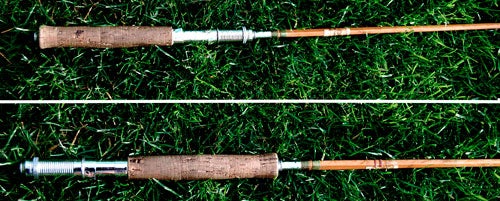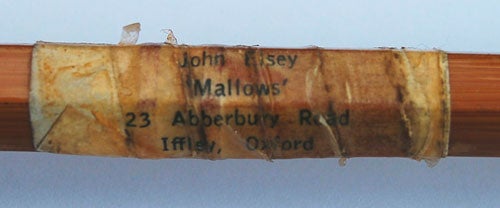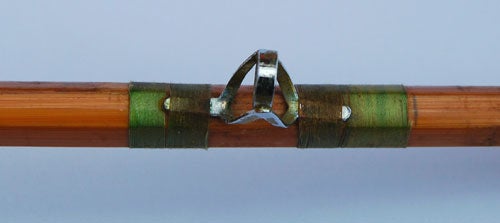| KEVIN PERKINS | |
|
Rebuilding old rods – Part 2Well, time for an update. Having foolishly suggested I would attempt to rebuild (not going to claim my workmanship is anything like a grand as to be described as ‘restoration’) an old split cane rod, I scouted around for a suitable subject, bearing in mind that my choice had to meet some exacting criteria in that it: –a) Wouldn’t cost a fortune to buy and b) Wouldn’t reduce me to tears if I ballsed it up, and c) Wouldn’t cause the floppy-hatted brigade to come round and beat me with birch twigs if in the process or ‘restoration’ I destroyed some vital piece of angling history. A project to put a duplon handle, screw reel fitting and Fuji rings on a Chapman 550 in order to ‘upgrade ‘ it has been put on hold for a while for that very reason!
Anyway, a couple of days ago the postman delivered my latest acquisition, 99p worth of what was described as a ‘lightweight two-piece split cane rod’ Hmmm….. As soon as I opened the parcel I recognised that what I had in my hands was indeed a part of angling history. *
Many, many years ago, you could walk into your local tackle dealer and after handing over what amounted to a couple of weeks’ paper round money, you could walk out the proud possessor of a Japanese five or seven-piece split cane ‘combination’ rod. Such a fiendishly clever concept, that just by assembling the various bits in a variety of ways and utilising the reversible handle, you had a fly rod, float rod, leger/spinning rod and a pike/pier rod. Brilliant! You could now set out, ready to tackle just about anything with fins. It’s a wonder why they don’t make similar thing today. Well, not really, because such an outfit has its limitations, which probably more than outweigh any advantages. It’s not even a ‘Curates’ egg’ because at least that was good in parts. Anyway, what I have acquired is not in fact a two piece rod, but what are probably the last remaining three pieces of one of said combination rods, those being the reversible handle and two sections which means I have either a 51/2 ‘ spinning or fly fishing rod. As I think that a fly rod of that length may not have much appeal, I’ll call it a single-handed spinning rod from now on. So having bought a sow’s ear, can I possibly make a nylon pouchette out of it? Well after a good look round, there may be hope. When the rod is assembled it is a straight as a rainbow, almost certainly brought about by being leant up against a wall for years. But with some judicious re-alignment after the rod rings have been taken off, it may be just about passable. Not perfect, but certainly good enough to be classed as just about acceptable.
Giving the rod a ‘swish’ produced a marked ‘clunk’ in the ferrule area, but happily this is not wear, both ferrules have come unglued and are moving around on the cane. The rod rings will be replaced as a matter of course, the cork handle is not too shabby and may well scrub up nicely, and on first inspection the cane sections themselves appear sound, without any splits along the glue joins. Hopefully, with a little bit of TLC, I should end up with a nice little single-handed spinning rod, just right for flicking small spinners on rivers, ponds or canals (or on a certain Thames weir pool in front of a certain famous hotel, if I ever get invited back, that is). So project No.1 gets under way as a fairly simple makeover to begin with, more details to follow. The good news is that I have already managed to source suppliers of several bits and bobs necessary to repair/rebuild old rods, and I will include details of these in the next instalment. * Whilst the rod has no real intrinsic value, it is somewhat well travelled and brings along a small puzzle. I bought it from a gent in West Wales, but an old and battered label on the rod seems to suggest that at least one previous (and possibly the original) owner came from the Oxford area. Now, I’m curious to know if someone on FM might have any knowledge of said person? |














